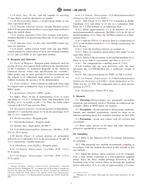Potrebujeme váš súhlas na využitie jednotlivých dát, aby sa vám okrem iného mohli ukazovať informácie týkajúce sa vašich záujmov. Súhlas udelíte kliknutím na tlačidlo „OK“.
ASTM D5932-08(2013)
Standard Test Method for Determination of 2,4-Toluene Diisocyanate (2,4-TDI) and 2,6-Toluene Diisocyanate (2,6-TDI) in Air (with 9-(N-Methylaminomethyl) Anthracene Method) (MAMA) in the Workplace
Automaticky preložený názov:
Štandardná skúšobná metóda pre stanovenie 2,4 - toluendiisokyanátu ( 2,4 - TDI ) a 2,6 - toluendiisokyanát ( 2,6 - TDI ) vo vzduchu ( s 9- ( N - Methylaminomethyl ) antracénového Method ) ( MAMA ) na pracovisku
NORMA vydaná dňa 1.4.2013
Informácie o norme:
Označenie normy: ASTM D5932-08(2013)
Poznámka: NEPLATNÁ
Dátum vydania normy: 1.4.2013
Kód tovaru: NS-33120
Počet strán: 6
Približná hmotnosť: 18 g (0.04 libier)
Krajina: Americká technická norma
Kategória: Technické normy ASTM
Anotácia textu normy ASTM D5932-08(2013) :
Keywords:
air monitoring, dual filter sampling system, high-performance liquid chromatography, sampling and analysis, toluene diisocyanate, workplace atmospheres, 9-(N-methylaminomethyl) anthracene, ICS Number Code 13.040.30 (Workplace atmospheres), 71.040.40 (Chemical analysis)
Doplňujúce informácie
| Significance and Use | ||||||||
|
5.1 TDI is used mostly in the preparation of rigid and semi-rigid foams and adhesives. 5.2 Isocyanate use has been growing for the last 20 years and the industrial need is still growing. 5.3 Diisocyanates and polyisocyanates are irritants to skin, eyes, and mucous membranes. They are recognized to cause respiratory allergic sensitization, asthmatic bronchitis, and acute respiratory intoxication (6-9). 5.4 The American Conference of Governmental Industrial Hygienists (ACGIH) has adopted a Threshold Limit Value–Time Weighted Average (TLV—TWA) of 0.036 mg/m3 with a Short-Term Exposure Limit (STEL) of 0.14 mg/m3 for 2,4-TDI (10). The Occupational Safety and Health Administration of the U.S. Department of Labor (OSHA) has a permissible exposure limit of 0.02 ppm(V) or 0.14 mg/m3 of TDI as a ceiling limit and 0.005 ppm (V) or 0.036 mg/m3 as a time-weighted average (11). 5.5 Monitoring of respiratory and other problems related to diisocyanates and polyisocyanates is aided through the utilization of this test method, due to its sensitivity and low volume requirements (15 L). Its short sampling times are compatible with the duration of many industrial processes and its low quantification limit also suits the concentrations often found in the working area. 5.6 The segregating sampling device pertaining to this proposed test method physically separates gas and aerosol allowing isocyanate concentrations in both physical states to be obtained, thus helping in the selection of ventilation systems and personal protection. 5.7 This test method is used to measure gaseous concentrations of 2,4- and 2,6-TDI in air for workplace and ambient atmospheres. |
||||||||
| 1. Scope | ||||||||
|
1.1 This test method covers the determination of gaseous 2,4-toluene diisocyanate (2,4-TDI) and 2,6-toluene diisocyanate (2,6-TDI) in air samples collected from workplace and ambient atmospheres. 1.2 Differential air sampling is performed with a segregating device.2,3 The gaseous fraction is collected on a glass fiber filter (GFF) impregnated with 9-(N-methylaminomethyl) anthracene (MAMA). 1.3 The analysis of the gaseous fraction is performed with a high performance liquid chromatograph (HPLC) equipped with ultraviolet (UV) and fluorescence detectors. 1.4 The analysis of the aerosol fraction is performed separately as described in Ref (1).4 1.5 The range of application of this test method, utilizing UV and a fluorescence detector, is validated for 0.029 to 1.16 μg of monomer 2,4- and 2,6-TDI/2.0 mL of desorption solution, which corresponds to concentrations of 0.002 to 0.077 mg/m3 of TDI based on a 15-L air sample. This corresponds to 0.28 to 11 ppb(V) and brackets the established TLV value of 5 ppb(v). 1.6 A field blank sampling system is used to check the possibility of contamination during the entire sampling and analysis. 1.7 The values stated in SI units are to be regarded as the standard. 1.8 This standard does not purport to address all of the safety concerns, if any, associated with its use. It is the responsibility of the user of this standard to establish appropriate safety and health practices and determine the applicability of regulatory limitations prior to use. |
||||||||
| 2. Referenced Documents | ||||||||
|




 Cookies
Cookies
